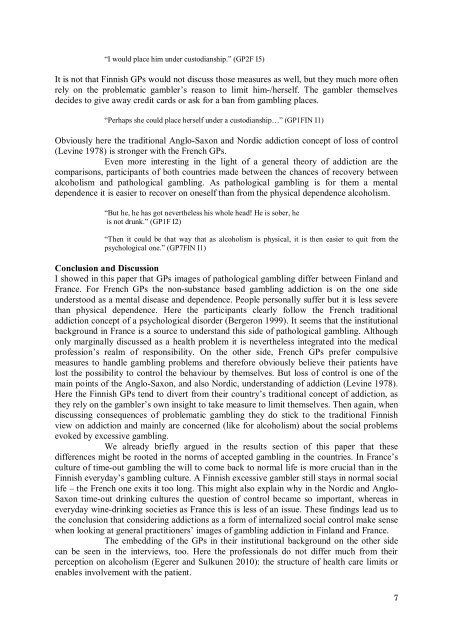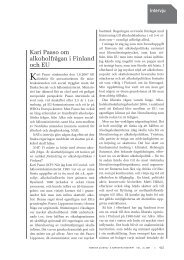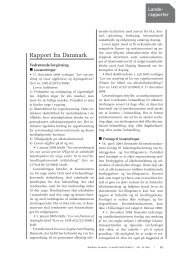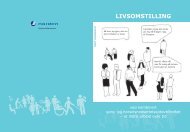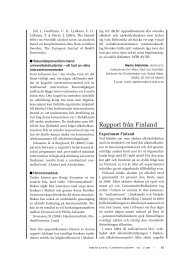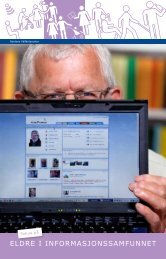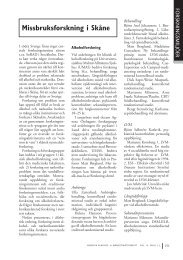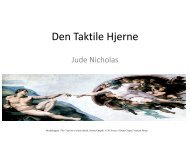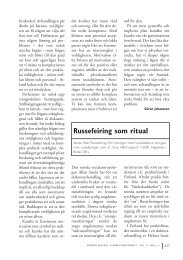- Draft paper. Please do not quote, nor distribute without authors ...
- Draft paper. Please do not quote, nor distribute without authors ...
- Draft paper. Please do not quote, nor distribute without authors ...
You also want an ePaper? Increase the reach of your titles
YUMPU automatically turns print PDFs into web optimized ePapers that Google loves.
“I would place him under custodianship.” (GP2F I5)It is <strong>not</strong> that Finnish GPs would <strong>not</strong> discuss those measures as well, but they much more oftenrely on the problematic gambler’s reason to limit him-/herself. The gambler themselvesdecides to give away credit cards or ask for a ban from gambling places.“Perhaps she could place herself under a custodianship…” (GP1FIN I1)Obviously here the traditional Anglo-Saxon and Nordic addiction concept of loss of control(Levine 1978) is stronger with the French GPs.Even more interesting in the light of a general theory of addiction are thecomparisons, participants of both countries made between the chances of recovery betweenalcoholism and pathological gambling. As pathological gambling is for them a mentaldependence it is easier to recover on oneself than from the physical dependence alcoholism.“But he, he has got nevertheless his whole head! He is sober, heis <strong>not</strong> drunk.” (GP1F I2)“Then it could be that way that as alcoholism is physical, it is then easier to quit from thepsychological one.” (GP7FIN I1)Conclusion and DiscussionI showed in this <strong>paper</strong> that GPs images of pathological gambling differ between Finland andFrance. For French GPs the non-substance based gambling addiction is on the one sideunderstood as a mental disease and dependence. People personally suffer but it is less severethan physical dependence. Here the participants clearly follow the French traditionaladdiction concept of a psychological disorder (Bergeron 1999). It seems that the institutionalbackground in France is a source to understand this side of pathological gambling. Althoughonly marginally discussed as a health problem it is nevertheless integrated into the medicalprofession’s realm of responsibility. On the other side, French GPs prefer compulsivemeasures to handle gambling problems and therefore obviously believe their patients havelost the possibility to control the behaviour by themselves. But loss of control is one of themain points of the Anglo-Saxon, and also Nordic, understanding of addiction (Levine 1978).Here the Finnish GPs tend to divert from their country’s traditional concept of addiction, asthey rely on the gambler’s own insight to take measure to limit themselves. Then again, whendiscussing consequences of problematic gambling they <strong>do</strong> stick to the traditional Finnishview on addiction and mainly are concerned (like for alcoholism) about the social problemsevoked by excessive gambling.We already briefly argued in the results section of this <strong>paper</strong> that thesedifferences might be rooted in the <strong>nor</strong>ms of accepted gambling in the countries. In France’sculture of time-out gambling the will to come back to <strong>nor</strong>mal life is more crucial than in theFinnish everyday’s gambling culture. A Finnish excessive gambler still stays in <strong>nor</strong>mal sociallife – the French one exits it too long. This might also explain why in the Nordic and Anglo-Saxon time-out drinking cultures the question of control became so important, whereas ineveryday wine-drinking societies as France this is less of an issue. These findings lead us tothe conclusion that considering addictions as a form of internalized social control make sensewhen looking at general practitioners’ images of gambling addiction in Finland and France.The embedding of the GPs in their institutional background on the other sidecan be seen in the interviews, too. Here the professionals <strong>do</strong> <strong>not</strong> differ much from theirperception on alcoholism (Egerer and Sulkunen 2010): the structure of health care limits orenables involvement with the patient.7


